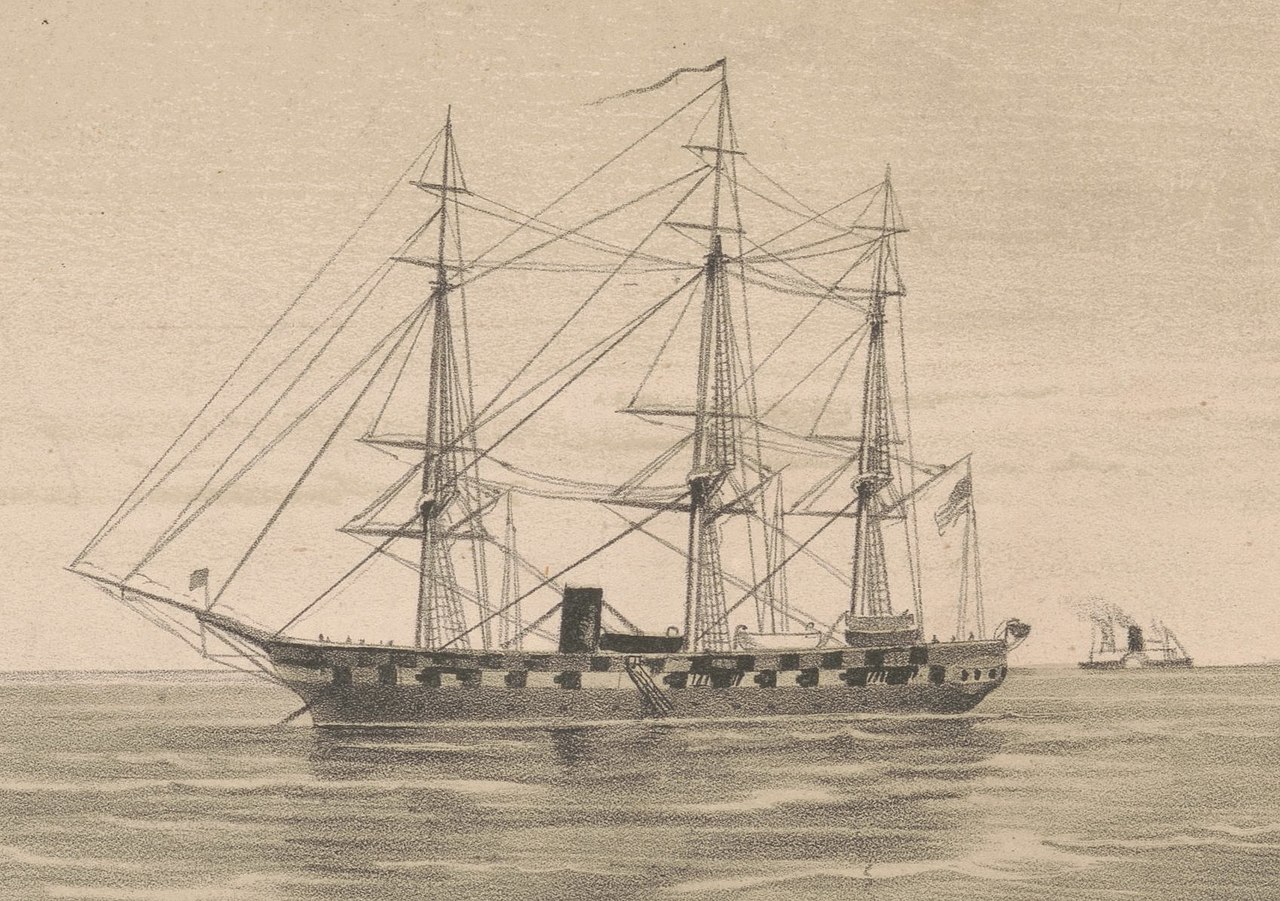
The Port of New York: Bird’s Eye View from the Battery Looking South, , 19th century - Yale New Haven Art Gallery
Martin Bell was born in Sweeden and went to sea when he was 19 years old. Martin Bell served on merchant ships for 19 years and on US man of war Ships for 19 years. He served in the Mexican American War on the USS Potomac and USS Decatur. After the Mexican American War, Martin Bell received a land grant, which he sold for $150.00. Martin Bell would enter Sailors' Snug Harbor in September of 1848. In 1850 he was expelled from the Harbor for drinking. Martin Bell would join the USS Congress and sail to the Mediterranean. When he returned from duty in the Mediterranean, he would ship on the steamer Minnesota. In 1859 Martin Bell was readmitted to Sailors' Snug Harbor. Martin would remain at the Harbor for 28 years, seven months, and six days. Martin would die at 85 years old and is buried in Sailors' Snug Harbor Cemetery. Martin is buried in Plot 3, Row 2, grave 16, which gives a grave number of 966 according to the cemetery map.

Engraving of USS Natchez from "The Book of the Navy" by John Frost. 1842
Martin Bell was aboard the USS Natchez in 1833, when the ship was reactivated durring the South Carolina nullification crises. The nullification crisis occurred because a protective tariff levied against England was passed in Congress. This tariff protected Northern Interests but hurt the Agricultural South. John C Calhoon, who was against nullification, stated in 1828 that the laws passed by the Federal Government were subject to State Rights (Maier,11). If a law passed by the Federal Government was detrimental to the economic interests of South Carolina, then that law could be ignored (Maier,11). Calhoon’s doctrine, which was meant to help prevent South Carolina from seceding from the Union, almost gave the people the reason they needed to do so in 1832 (Maier, 11 - 12). Unjust taxation, which is what the tariff added up to, was the same to South Carolinians as the Stamp Acts that brought about the American Revolution (Maier,3).
Along with Martin Bell, the USS Natchez sailed for Charleston on January 2, 1833 (Naval History and Heritage Command -Natchez). The USS Natchez was anchored in Rebellion Roads on January 19, 1833 (Naval History and Heritage Command). On March 12, 1833, the USS Natchez sailed to the Charleston Battery, where it remained until tensions were eased when Congress passed a lower tariff on England (Naval History and Heritage Command). The USS Natchez then sailed for Hampton Roads, Virginia, on April 4, and when the Natchez arrived in Norfolk, Virginia, she was placed in ordinary (Naval History and Heritage Command - Natchez).

USS Decatur "Beating round 'Cape Freward': Straits of Magellan, Dec: 1854"() - signed J.Y.T. (probably John Y. Taylor, Assistant Surgeon)
Martin Bell joined the USS Decatur that sailed from Hampton Roads, Virginia, to the Pensacola Navy Yard and then to Castle Juan de Ulloa, Mexico, for duty in the Mexican American War. Decatur arrived on April 14, 1847 (Naval History and Heritage Command - Decatur). The Decatur was too large to assist the steamships Spitfire, Scourage, Vixen, and others for action along the Mexican Rivers ( see Charles Risby ). However, the Decatur cruised Mexican waters and supplied 14 of her officers and 118 men to accompany Commodore Perry’s expedition to attack Tuxpan, Mexico. The Decatur also provided officers and seamen for the capture of Tobasco, Mexico. On September 2, 1847, the Decatur sailed for Boston, arriving on November 12, 1847 (Naval History and Heritage Command - Decatur).In September of 1848, Martin Bell entered Sailors' Snug Harbor almost a year later. Martin Bell also served with the USS Potomac, a Frigate during the Mexican American War. The Potomac assisted General Zachary Taylor's army at the battle of Palo Alto and participated in the siege of Vera Cruz on March 9, 1847 (Naval History and Heritage Command - Potomac)

"USS Congress (1842-1862), right and USS Susquehanna (1850-1883), left distance Oil painting by DeSimone, depicting the ships at Naples in 1857" - U.S. Navy Art Collection, Washington, D.C.
Martin Bell was expelled From Sailors' Snug Harbor for Drinking on February 5, 1850. He would join unto the USS Congress. The Congress departed Hampton Roads on June 12, 1850. She arrived in Rio de Janeiro on September 1 and assumed duty as Flag Ship of the Brazil Squadron. The USS Congress was assigned a threefold mission, protecting US Merchant Ships and the less populated coastal regions of the U.S. (DANFS Online). The prevention of using the United States Flag to cover the African Slave trade and maintaining the U.S. neutral rights among hostilities between South American Countries (DANFS Online).The USS Congress returned to New York on July 20, 1853, and was decommissioned.

USS Minnesota (1855) U.S. Naval review at Hampton-Roads VA. in 1880 - Lithograph after a drawing by Joseph L. Jones, circa 1877-1880
Between 1856 and 1857, the Second Opium War broke out between the British, French, and Chinese. The war disrupted trade across East Asia. The U.S. dispatched three ships to protect the American merchantmen trading in the region. Minnesota, a wooden steam frigate, Sloop of War Germantown and Side-wheeler Steamer , shipped from Norfolk and New York and headed to the Orient on August 4 and 19, 1857. Martin Bell shipped on the USS Minnesota. The USS Minnesota had orders to join the East India Squadron and then to sail from Hong Kong to bring William B. Reed, minister of China, back to the United States. Reed had negotiated a new treaty of commerce between the United States and China. On April 20, 1859, Minnesota completed its mission and sailed for Boston’s Navy Yard. Minnesota arrived in Boston Harbor on June 2, 1859.